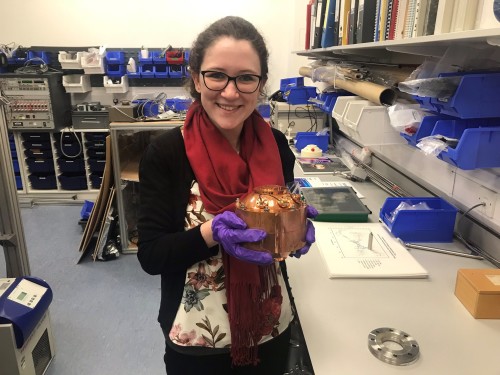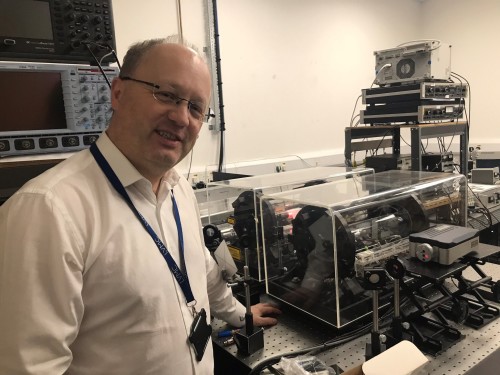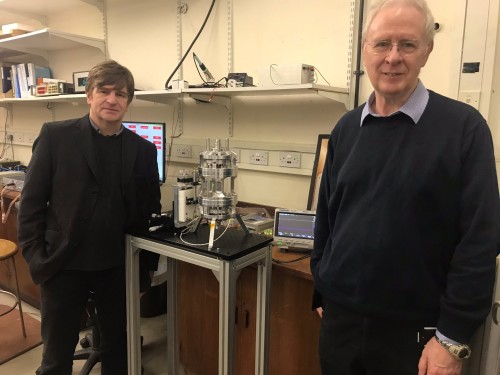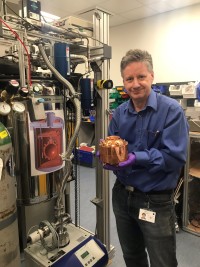
Hands-on physics – Sarah Tesh with a replica of the device used to measure temperature at the National Physical Laboratory
By Matin Durrani and Sarah Tesh
Here at Physics World we’re planning to publish special issues later this year on time (in July) and on SI units and measurement (in November). So to find out more about the latest work in these fields, we decided to accept a long-standing invitation to visit the National Physical Laboratory in Teddington, just outside London, yesterday.
The NPL is the UK’s national measurement laboratory and, as we found out on our visit yesterday, it’s home to almost 900 staff. Or, to be precise, there are 879 staff – after all, accuracy is the name of the game for the NPL, which provides vital measurement services to industry and plays a key part in global attempts to revise the SI measurement system.
It was a busy day for us and we came away with some useful ideas for possible articles for those two Physics World special issues. But rather than giving you a detailed run-down of everything we saw, here instead are 12 “fun” facts we picked up during our visit. Sometimes it’s those little details that make lab visits so intriguing.
1 The NPL houses what it calls “the most accurate thermometer on Earth”, which yields Boltzmann’s constant by measuring the speed of argon atoms.
2 The experiment is run by Michael de Podesta, who says the most famous person to visit his experiment has been the actor and writer Stephen Fry.
3 Until 1963, the metre was defined using etchings on a metal bar with an X-shaped cross section made from 80% platinum and 20% iridium.
4 The NPL’s copy of the “Tresca bar”, which is now redundant, has a scrap-metal value of £150,000 and is hidden in a vault that can only be accessed by four staff, who have special keys.
5 The metre is now defined in terms of the speed of light and the NPL has five helium-neon lasers, which companies can have their own lasers calibrated against.
6 The lasers are called Mildred, Donald, R18, Sydney and G14. Donald is the best of the lasers and Andrew Lewis– the lab’s “head of length” – joked that this Donald was “the most stable thing we have”.

Metre master – Andrew Lewis, the National Physical Laboratory’s wonderfully titled “head of length”, actually has to be more of an expert in measuring frequencies
7 The NPL has a secret lab where scientists are trying to create a working “indoor GPS” system, which would locate the position of objects to micrometre accuracy using the same principle that mobile phones are pinpointed thanks to satellites.
8 The NPL is the birthplace of the “Watt balance”, which measures mass by balancing gravitational and electrical force, and is also known as the “Kibble balance” after its inventor Bryan Kibble (1938-2016), who worked at the lab for many years.
9 The NPL has housed two of the 10 or so Watt balances that have ever been built, but the magnet from the first balance can’t be moved out of its home in the historic Bushey House because it weighs six tonnes.
10 Physicists hope to redefine the SI unit of mass at the 28th meeting of the General Conference on Weights and Measures (CGPM), in Versailles, France, in November (and one reason Physics World is pubishing its special issue on SI units and measurement). The current SI unit for the kilogram is based on a lump of metal in Paris that has to be cleaned sporadically using goat’s skin soaked in ethanol.
11 Ian Robinson and colleagues at the NPL are trying to build a small version of a Watt balance that can be used by companies once the kilogram has been redefined.

Mass masters – Ian Robinson (right) and Stuart Davidson with their test version of a small-scale Watt balance
12 The NPL also works on airborne particle metrology, with Paul Quincey among those studying “black carbon” – soot particles spewed out from vehicles. These particles and others are responsible for about a quarter of anthropogenic climate change.
We learned a lot more than the above of course – and there’s a huge amount of work at the lab we didn’t get time to see. Still, for more on metrology, stay tuned for our upcoming special issue. In the meantime, don’t miss Michael de Podesta’s feature on measuring temperature and this great overview about the idea behind redefining SI units.

Guidelines
Show/hide formatting guidelines
this text was deletedwhere people live in harmony with nature and animals</q>
Some text